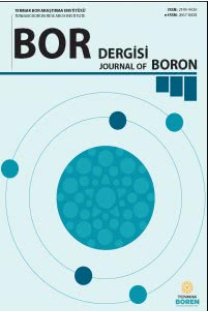Experimental and DFT calculation studies on boric acid and salicylic acidboric acid-ethanol solution
Experimental and DFT calculation studies on boric acid and salicylic acidboric acid-ethanol solution
In the present study, the vibrational analysis of boric acid molecule and boric acidsolution prepared as a magistral ear drug was experimentally performed and itschemical characteristics was examined for the first time using FT-IR and NMRchemical shift spectra. The boric acid and salicylic acid powders were analyzedby X-ray powder diffraction. The particle size of boric acid and salicylic acid weredetermined as 457 μm in Dv(50) and 59.8 μm in Dv(50) respectively using particlesize analysis device. The optimized molecular structure, vibrational wavenumbersand the highest and the lowest occupied molecular orbital analyses of boric acidmolecule were theoretically obtained with DFT method at the B3LYP/6-311++G(d,p)basis set. The vibrational wavenumbers were found to be consistent with theliterature results and the experimental data obtained in the current work. Boricacid solution was found to exhibit antimicrobial activity after the agar disk diffusionand agar well diffusion tests performed on Candida albicans (ATCC 10231) strain.
___
- Yünlü K., Bor: Bileşikleri, Sentez yöntemleri, Özellikleri, Uygulamaları., Ulusal Bor Araştrma Enstitüsü, 2016.
- Ullman’s Encyclopedia of Industrial Chemistry, Boron Compounds, 5th edition., Vol A4, 1985
- Bezerra da Silva M., dos Santos R. C. R. , da Cunha A. M., Valentini A. , Pessoa O. D. L., Caetano E. W. S. and Freire V. N. , Structural, Electronic, and Optical Properties of Bulk Boric Acid 2A and 3T Polymorphs: Experiment and Density Functional Theory Calculations, Cryst. Growth Des., 16 (11), 6631–6640, 2016
- See A. S., Salleh A. B., Bakar F. A., Yusof N. A., Abdulamir A.S., Heng L.Y., Risk and Health Effect of Boric Acid, Am. J. Appl. Sci. 7 (5), 620-627, 2010.
- Borik Asit Güvenlik Bilgi Formu, Eti Maden İşletmeleri Genel Müdürlüğü, 2012, http://www.mdnmuhendislik. com/FileUpload/bs658719/File/asit-borik.pdf.
- Zachariasen W. H., The Crystal Lattice of Boric Acid, BO3H3. Z. Kristallogr, Cryst. Mater., 88 (1−6), 150−161, 1934.
- Zachariasen W. H., The Precise Structure of Orthoboric Acid Acta Cryst. 7, 305, 1954.
- Stefani D., Pashalidis I., Nicolaides A. V., Journal of Molecular Structure: THEOCHEM 853, 33–38, 2008.
- Magistral Pharmacy Guide, Turkish Pharmacists Association Publications, Fersa Ofset, 3.edition, 2015.
- Becke A. D., J. Chem. Phys. 98, 5648-5652, 1993
- Lee C., Yang W., Parr R. G., Phys. Rev. B, 37, 785- 789, 1988.
- Frish A., Nielsen A. B., Holder A. J., Gauss View User Manual, Gaussian Inc., Pittsburg, PA, 2001.
- Frisch M. J., Trucks G. W., Schlegel H. B., Scuseria G. E., Robb M. A., et al., Gaussian 09, Revision, A.1, Gaussian Inc., Wallingford CT, 2009
- Gaussian website, Visualizing Molecules&Reactions with Gaussview 5. http://www.gaussian.com/g_prod/ gv5.htm (accessed 10.01.2018).
- Sundaaraganesan N., Ilakiamani S., Saleem H., Wojciechowski P. M., Michalska D., Spectrochim. Acta A, 61, 2995, 2005.
- AIST, (2017). National Institute of Advanced Industrial Science and Technology Spectral Database for Organic Compounds, SDBS. http://sdbs.db.aist.go.jp/ sdbs/cgibin/cre_index.cgi, (Accessed on 10 February 2018).
- Kayı H., Theoretical investigation of carbon dioxide capture by aqueous boric acid solution: A termolecular reaction mechanism, BORON 3 (1), 1 - 7, 2018.
- Peak D., Luther G. W., Sparks D. L., ATR-FTIR spectroscopic studies of boric acid adsorption on hydrous ferric oxide, Geochimica et Cosmochimica Acta, Vol.67, No.14, pp. 2551-2560, 2003.
- Harabor A., Rotaru P., Scorei R. I, Harabor N. A., Nonconventional hexagonal structure for boric acid, J. Therm. Anal. Calorim., 118: 1375-1384 2014
- Mergen A., Demirhan M. H., Bilen M., Processing of boric acid from borax by a wet chemical method, Advanced Powder Technol., Vol.14, No.3, pp. 279-293 (2003).
- Sardi J. C. O., Scorzoni L., Bernardi T., Fusco-Almeida A. M., Mendes Giannini M. J. S., Candida species: current epidemiology, pathogenicity, biofilm formation, natural antifungal products and new therapeutic options, J. Med. Microbiol., 62, 10–24, 2013.
- Hassawi D., Kharma A., Antimicrobial Activity of Some Medicinal Plants Against Candida Albicans, Journal of Biological Sciences 6 (1), 109-114, 2016.
- Sharifynia S., Badali H., Sharifi Sorkherizi M., Shidfar M. R., Hadian A., Shahrokhi S., et al. In vitro antifungal susceptibility profiles of Candida albicans complex isolated from patients with respiratory infections, Acta Med Iran 54 (6), 376-81, 2016.
- Dixon D.M., Walsh T.J., Antifungal agents, In: Baron S (Ed.), Medical microbiology, 4th edition, Galveston (TX): University of Texas Medical Branch at Galveston; Chapter 76, 1996.
- Silva da I. C. G. et al., Antifungal activity of eugenol and its association with nystatin on Candida albicans, Pesquisa Brasileira em Odontopediatria e Clinica Integrada, 17 2017.
- Abbasoğlu U., Çevikbaş A., Farmasötik mikrobiyoloji, Efil Yayınevi, 2015.
- ISSN: 2149-9020
- Yayın Aralığı: Yılda 4 Sayı
- Başlangıç: 2016
- Yayıncı: TENMAK Bor Araştırma Enstitüsü
Sayıdaki Diğer Makaleler
Dry sliding behaviour of boron waste reinforced epoxy matrix composites
Nurcan ÇALIŞ AÇIKBAŞ, Bilge YAMAN
Serpil IŞIK, Yusuf Ziya HALEFOĞLU
Ahmet YARTAŞI, Tuba Hatice DOĞAN
The nanobiocomposites synthesis from biomass and its characterization
Nuran AY, Emir Zafer HOŞGÜN, Berrin BOZAN, Yapıncak GÖNCÜ
Experimental and DFT calculation studies on boric acid and salicylic acidboric acid-ethanol solution
Tuba ÖZDEMİR ÖGE, Ali Ünsal KESKİNER
Tuba Hatice DOĞAN, Ahmet YARTAŞI
Selim UYSAL, Jed CAPPELLAZZİ, Jeffrey MORRELL
Bilge Yaman, Nurcan Çalış Açıkbaş
ÜLEKSİT VE BORAKS İÇEREN FREN SÜRTÜNME MALZEMELERİNİN TRİBOLOJİK ÖZELLİKLERİ
